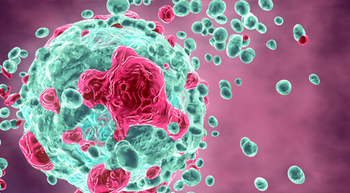
TIL Therapy May Be the Curative Answer for Metastatic Melanoma
Tumor-infiltrating lymphocytes show great promise in the metastatic melanoma space, but questions remain.
Tumor-infiltrating lymphocytes (TIL), a neoantigen-targeting therapy, has been shown to be a potentially curative treatment for patients with metastatic melanoma, and has led to clinical responses in this population even after failure with checkpoint inhibitors, according to Inge Marie Svane, MD, PhD.1
However, several questions remain with this therapeutic approach, Svane, a professor in Clinical Cancer Immune Therapy at the University of Copenhagen, and director of National Center for Cancer Immune Therapy at Herlev and Gentofte Hospital, said in a presentation during the AACR Annual Meeting 2021.
“We don’t really know the whole truth about antigen specificity driving TIL efficacy. We know that some of the tumor-reactive TILs represent neoantigen-specific T cells, [while] some represent more shared or tumor-associated antigens, and some may be viral antigens; however, there is also a population of these tumor-reactive T cells that are still unknown to us,” Svane explained. “We need to improve on how we can define TIL potency to document the efficacy of this therapy, and we need to clarify the role of CD4 T cells in the product. [Another] broad area of [interest is] to figure out how to increase the efficacy of TIL therapy in non-melanoma cancers.”
Adoptive Cell Therapy Based on TILs
TILs represent the most developed strategy for neoantigen-targeting immunotherapy, and it is well known that this therapy has shown efficacy in infiltrating tumors, Svane said. Additionally, efforts to expand, isolate, and stimulate TILs have been examined, according to Svane.2
“We can show that a certain fraction of these expanded cells react toward the tumor, Svane said. “In this subpopulation of tumor-reactive T cells, we find neoantigen-specific T cells, as well as tumor-associated antigen-specific T cells, and T cells reactive toward viral antigens like human papillomavirus [HPV]. Then, the last fraction of these tumor-reactive T cells are of unknown specificity.”
Adoptive T-cell therapy is established by taking tumor tissue from the patient and driving out the T cells from the tumor lesion, which is followed by initial TIL expansion. In the last 2 weeks, TIL is rapidly expanded through the stimulation of anti-CD3 feeder cells and high doses of interleukin (IL)-2 to achieve 50 to 200 x 109 TILs for infusion, according to Svane. Patients are preconditioned with high-dose chemotherapy for 1 week prior to infusion with the TILs. Then, the TILs are infused and thereafter they are supported with high doses of IL-2.
This method for TIL infusion was established over a decade ago and published data showed response rates ranging from 50% to 70% in patients with metastatic melanoma. Additionally, more than 20% of patients experienced long-term survival with this therapy. Twenty patients achieved a complete response (CR); among these complete responders, the 3-year survival rate was 100%, and the 5-year survival rate was 93%.3
“With a long-term follow-up of more than 8 years, the National Cancer Institute has recently shown that this is an extremely durable response if the patients achieved CR, and it is highly likely that they will be cured of their metastatic melanoma,” Svane said.
In another phase 1/2 study (NCT00937625), adoptive cell therapy with TILs was examined in patients with metastatic melanoma who had progressed on prior treatment with high-dose IL-2 and ipilimumab (Yervoy). Overall, 25 patients were enrolled to the study and underwent a 3-step treatment comprised of high-dose chemotherapy, TIL infusion, and IL-2.4 The overall response rate (ORR) achieved with this regimen was 42%, and once again, patients who achieved a CR demonstrated a long duration of response (DOR) to treatment, according to Svane.
Additionally, results from a meta-analysis that examined studies that administered adoptive cell therapy with TILs at treatment centers worldwide showed that durability of response can be experienced with this treatment if a CR is achieved.5
Responses in PD-1–Resistant Melanoma With TILs
Anti–PD-1 therapy is one of the main treatment strategies for patients with metastatic melanoma, according to Svane, and as such, it was important for investigators to examine whether adoptive cell therapy with TILs can be utilized in patients who had progressed on this therapy.
“We showed in a small cohort of patients that we were, indeed, able to induce remission of metastatic lesions in patients progressing on anti-PD-1 [agents],” Svane said. “We also found tumor-reactive T cells in the product as well as in the peripheral blood after treatment. [However,] the durability of the treatment seems to be shorter lasting.”
This was also demonstrated in a study that examined clinical responses to TIL therapy in patients who were PD-1 naïve (n = 32) vs those who had progressed on previous PD-1 treatment (n = 23). Results showed a response rate of 42% in PD-1–naïve patients vs 32% in those who had progressed on PD-1 treatment.6 The median overall survival (OS) in these 2 cohorts was 19.6 months and 14.0 months, respectively, while the median progression-free survival (PFS) was 3.9 months and 2.8 months, respectively. Additionally, the DOR for patients who achieved a CR and partial response (PR) was 32.2 months for PD-1–naïve patients vs 7.6 months for those who had progressed on PD-1 treatment.
“The number of patients who had a response were lower when they had previously progressed on a checkpoint inhibitor and the durability of responses was far shorter [in those who were] refractory to PD-1 therapy,” Svane noted.
Additionally, data from a study presented during the 2020 ASCO Virtual Scientific Program demonstrated that when the cryopreserved TIL product lifileucel (LN-144) was used in patients with PD-1–resistant melanoma, the ORR achieved was 36.4%.7 Moreover, 81% of patients treated in this study (n = 50/62) experienced a reduction in tumor burden with the treatment.
Examining TIL Therapy Beyond Melanoma
Only a small number of studies examining TIL therapy in patients with other cancers beyond melanoma have been published, and very few trial results have been finalized, according to Svane.
However, one of the published studies examined treatment with HPV-targeted TILs in 9 patients with metastatic cervical cancer. Results showed durable complete regression with the approach, with 3 patients experiencing objective tumor responses to treatment.8 Additionally, a phase 1 study (NCT03215810) examined adoptive cell transfer with TILs in 13 patients with non–small cell lung cancer (NSCLC) and durable CRs were reported in some of these patients.9
Notably, TIL therapy also led to a durable CR in a patient with metastatic breast cancer, according to a patient report published in Nature Medicine.10 “The treatment that they offered this patient was very complex, as they aimed to increase the number of new antigens between T cells in the TIL product,” Svane explained.
To do this, the investigators sequenced the tumor from the patient and predicted different neoepitopes. Based on that prediction, investigators prepared minigenes, which were transduced into dendritic cells established from the patients; this was so the dendritic cell could then present the neoantigen epitopes to the TILs during the outgrowth, and increase the fraction of neoantigen-specific T cells in the infusion product.
“Indeed, they saw very impressive responses, with multiple lesions disappearing after therapy,” Svane noted.
Additionally, an ongoing phase 1/2 trial (NCT03296137) is examining TIL therapy in 25 patients with advanced cancer who have been heavily pretreated, including with anti–PD-1 therapy. Of the patients treated on this study, 7 have GI cancers (28%), 6 have melanoma (24%), 3 have cholangiocarcinoma (12%), 2 have squamous cell carcinoma (8%), 2 have sarcoma (8%), and 5 have other carcinomas (20%).11
On this study, investigators sought to take advantage of treatment with checkpoint inhibitors at different points throughout treatment, according to Svane. Patients were pretreated with 1 dose of ipilimumab to recruit more TILs into the tumor lesion, as well as to expand the repertoire of the TILs prior to tumor resection. After conditioning with chemotherapy, patients were then infused with the TILs, and received treatment with 4 doses of nivolumab (Opdivo). Additionally, patients received treatment with low-dose IL-2 for 14 days.
Results from this study showed that some patients did achieve regressive disease with this therapy, and 5 out of 25 patients demonstrated substantial tumor regression, according to Svane. However, the durability of these responses was short.
Treatment with TIL therapy has also been examined in several pilot studies in patients with ovarian cancer. In one study that examined TIL therapy without the addition of checkpoint inhibitors, results showed that patients only achieved disease stabilization, according to Svane.12 However, in another study, that utilized ipilimumab and nivolumab to increase TIL efficacy, responses deepened, Svane explained.13
Future Directions Toward Standard of Care
Currently, an ongoing, randomized phase 3 trial is comparing TIL-based adoptive cell therapy vs standard ipilimumab treatment in patients with PD-1–resistant melanoma, according to Svane. The goal is to enroll 168 patients with metastatic melanoma who have progressed on prior anti–PD-1 therapy.
Patients will be randomized 1:1 to receive ipilimumab at a daily dose of 3 mg/kg every 3 weeks for 4 cycles (arm A) or nonmyeloablative chemotherapy comprised of cyclophosphamide plus fludarabine followed by intravenous (IV) adoptive transfer of at least 5 x 109 TIL followed by high-dose IL-2 (arm B). Patients will be stratified by BRAF V600 mutational status (yes vs no), line of treatment (first vs second), and treatment center.
The primary end point of the study is 6-month PFS, while secondary end points include PFS per immune-related response criteria (irRC), ORR per RECIST v1.1 criteria and irRC, as well as CR, OS, and safety.
“Accrual has been moving along and has been successful for the past couple of years. We aim to have the full recruitment of the trial within the next year,” Svane said.
Predictors of Response
In terms of which patients could be the best candidates to receive TIL therapy as a potential standard of care, a lot of information has been gathered from past studies, according to Svane. Ideal patients are younger than 70 years, have at least 1 resectable metastatic lesion of sufficient size, and have a good clinical performance status. Additionally, patients with metastatic melanoma, who have progressed after standard therapy, with no brain metastases and sufficient organ function, have demonstrated the best responses with this approach.
However, questions regarding predictive factors and markers of response remain, Svane noted. It has been suggested that mutational load and inflammation may be potential biomarkers.
“Indeed, mutational load correlates with clinical benefit, and it also correlates with PFS, as well as OS for patients treated with T-cell therapy,” Svane said. Moreover, immune system activation profile has been shown to be a hallmark of responding tumors.
Moreover, immunology has been found to correlate with tumor regression, with the number of T cells in the infusion product reacting toward the tumor playing a key role in efficacy, according to Svane. As such, the patients with the best reduction of tumor lesions had the highest number of tumor-reactive TILs in the infusion product.14 This was also seen in blood samples collected months after treatment.
Additionally, a qualitative analysis of expanded TILs across multiple tumor types, significantly more tumor-reactive T cells were found in the products for patients with melanoma compared to those with other types of cancer, according to Svane.15
“This is, indeed, [the case] for both the CD8 cells, as well as the CD4 cells,” Svane said. “If you look at the total percentage of tumor-reactive T cells, we have generally more CD8 tumor-reactive T cells than CD4s, but these 2 fractions do correlate.”
Moreover, stem-cell–like CD8 T cells in TIL infusion products were also found to be associated with clinical responses, as well as survival. These T cells, CD39-negative and CD69-negative, correlated with complete cancer regression, according to Svane. Additionally, while most antitumor neoantigen-reactive TILs were found in a differentiated CD39-positive state, those who responded to treatment also maintained CD39-negative neoantigen-specific TILs.16
References
- Svane I. Targeting neoantigens by adoptive cell therapy. Presented at: 2021 AACR Annual Meeting; May 17-21, 2021; Virtual. Session ED071.
- Donia M, Junker N, Ellebaek E, et al. Characterization and comparison of ‘standard’ and ‘young’ tumor-infiltrating lymphocytes for adoptive cell therapy at a Danish translational research institution. Scand J Immunol. 2012;75(2):157-167. doi:10.1111/j.1365-3083.2011.02640.x
- Rosenberg SA, Yang JC, Sherry RM, et al. Durable complete responses in heavily pretreated patients with metastatic melanoma using T-cell transfer immunotherapy. Clin Cancer Res. 2011;17(13):4550-4557. doi:10.1158/1078-0432.CCR-11-0116
- Andersen R, Donia M, Ellebaek E, et al. Long-lasting complete responses in patients with metastatic melanoma after adoptive cell therapy with tumor-infiltrating lymphocytes and an attenuated IL2 regimen. Clin Cancer Res. 2016;22(15):3734-3745. doi:10.1158/1078-0432.CCR-15-1879
- Dafni U, Michielin O, Lluesma SM, et al. Efficacy of adoptive therapy with tumor-infiltrating lymphocytes and recombinant interleukin-2 in advanced cutaneous melanoma: a systematic review and meta-analysis. Ann Oncol. 2019;30(12): 1902–1913. doi:10.1093/annonc/mdz398
- Borch TH, Andersen R, Ellebaek E, et al. Future role for adoptive T-cell therapy in checkpoint inhibitor-resistant metastatic melanoma. J Immunother Cancer. 2020;8(2):e000668. doi:10.1136/jitc-2020-000668
- Sarnaik A, Khushalani NI, Chesney JA, et al. Long-term follow-up of lifileucel (LN-144) cryopreserved autologous tumor infiltrating lymphocyte therapy in patients with advanced melanoma progressed on multiple prior therapies. J Clin Oncol. 2020;38(suppl 15):10006. doi:10.1200/JCO.2020.38.15_supple.10006
- Stevonavíc S, Draper LM, Langhan MM, et al. Complete regression of metastatic cervical cancer after treatment with human papillomavirus–targeted tumor-infiltrating T cells. J Clin Oncol. 2015;33(14):1543-1550. doi:10.1200/JCO.2014.58.9093
- Creelan B, Wang C, Teer J, et al. Durable complete responses to adoptive cell transfer using tumor infiltrating lymphocytes (TIL) in non-small cell lung cancer (NSCLC): a phase I trial. Clin Cancer Res. 2020;80(suppl 16). doi:10.1158/1538-7445.AM2020-CT056
- Zackarakis N, Chinnasamy H, Black M, et al. Immune recognition of somatic mutations leading to complete durable regression in metastatic breast cancer. Nat Med. 2018;24(6):724-730. doi:10.1038/s41591-018-0040-8
- Kverneland AH, Borch TH, Chamberlain C, et al. Clinical potential of adoptive cell therapy with tumour infiltrating lymphocytes therapy in combination with checkpoint inhibitors in non-melanoma patients. Ann Oncol. 2020;31(suppl 4):S706. doi:10.1016/j.annonc.2020.08.1142
- Pedersen M, Westergaard MCW, Milne K, et al. Adoptive cell therapy with tumor-infiltrating lymphocytes in patients with metastatic ovarian cancer: a pilot study. Oncoimmunology. 2018;7(12):e1502905. doi:10.1080/2162402X.2018.1502905
- Kverneland AH, Pedersen M, Westergaard MCW, et al. Adoptive cell therapy in combination with checkpoint inhibitors in ovarian cancer. Oncotarget. 2020;11(22):2092-2105. doi:10.18632/oncotarget.27604
- Andersen R, Dona M, Ellebaek E, et al. Long-lasting complete responses in patients with metastatic melanoma after adoptive cell therapy with tumor-infiltrating lymphocytes and an attenuated IL2 regimen. Clin Cancer Res. 2016;22(15):3734-3745. doi:10.1158/1078-0432.CCR-15-1879
- Gokuldass A, Draghi A, Papp K, et al. Qualitative analysis of tumor-infiltrating lymphocytes across human tumor types reveals a higher proportion of bystander CD8+ T cells in non-melanoma cancers compared to melanoma. Cancers (Basel). 2020;12(11):3344. doi:10.3390/cancers12113344
- Krishna S, Lowery F, Copeland A, et al. Stem-like CD8 T cells mediate response of adoptive cell immunotherapy against human cancer. Science. 2020;370(6522):1328-1334. doi:10.1126/science.abb9847
This article was originally published on OncLive as, "
Newsletter
Knowledge is power. Don’t miss the most recent breakthroughs in cancer care.

















































































